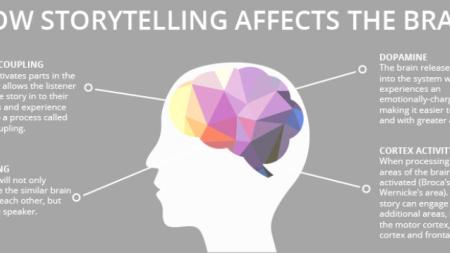
It's no secret that visual content is making its way to the forefront of content marketing strategies. Content that is visually stimulating, engaging, and interactive is critical to producing high-quality content for your audience.
Smart content marketing will incorporate all methods of getting their visual content out to their audience, but brilliant content marketing will focus their efforts on making their visual content tell a story.
Simply having visual content (images, infographics, etc.) on your website won't help your audience differentiate between you and your competitor. Creating a good story will make people pay attention and are worth remembering - making your brand more memorable.
When we read fact-driven data, only the language part of our brain decodes the meaning of the facts. When we read a story, the whole brain becomes engaged. We decipher the meaning behind the story, but it invokes creativity, memories, and encourages imaginative thoughts. Reading a story affects our brain the same way was if we were really experiencing what we were reading.
Now, think about turning that written story into a visual. If a story can engage a brain that much and still only retain 10% of the text, then think about how much more effective our story will be when we use visuals to tell our story. Our brain retains 95% of what we read/see when there are visual aids. Your marketing campaigns would be much more memorable and meaningful.
Sit down, it's story time

The reason it's so important to tell children stories is because it stimulates their brains and expands their creativity and imagination. Molding their brains to think outside-the-box is important for growth and education. Well, it's the same for adults.
Our brains are wired to crave stories. From a young age, we understand the difference between reading cold hard facts and reading a fascinating story - and we prefer stories. In fact, we become greedy for stories. Studies have shown that we spend 1/3 of our lives spinning into fantasies and daydreams.
So, why not take advantage of this?
If stories have the ability to mold our behavior and thinking, then telling a story in our marketing campaigns should be a no-brainer. These stories won't just be for escapism - they'll be drawing in our audience. The goal is to create a story so captivating that the brain won't drift off into a daydream while reading or watching our story. To harness our hyper minds and make them pay close attention to one thing for a few minutes is truly impressive. And it's our job to make it happen.
There are a few important facts to keep in mind when creating a story for marketing campaigns. Let's break it down and see some examples of visual content in action.
Be direct
This is very important to writing your story - don't make your audience dig around for the meaning. Our brains are lazy and won't want to do the extra work, so if you write a story that is clear and direct, you're already winning.
Don't be mistaken, being direct does not equal being boring. You can create a direct story while being engaging and interesting. Don't make your campaign boring or no one will care what kind of story you're telling: they won't make it past the first time. Which leads me to my next point...
Be interesting
The best way to create content that your audience finds interesting is to use user-generated content to help tell your story. Take ideas from FAQs and comments on blogs. If you create content that your audience is asking about, then you're answering their questions. That goes a long way in building a loyal customer base, because they think you are really listening. And you are!
Interesting content is good content. You want to draw your reader in and immerse them into your world. The more you can grab their attention and keep it, the closer you are to having the undivided attention of their ever-wandering brain. Remember, the goal is to keep their brain from drifting off into la-la-land.
Be unique
The key to creating a direct, interesting story is to fashion a story that hasn't been told before. This will take time and a team of creative brainstorming storytellers. It takes time to craft a well thought-out storyline that is unique, while being direct. This is where it might be valuable to hire a team of professionals that have experience telling stories and creating marketing messages around your story.
Chances are you don't have time to sit around and write a story about your brand that will be smart, catchy, memorable, and informational. In order to produce something that is inspiring to your audience, hiring visual professionals can lighten the load, and make the end product much more impressive.
Be ready
The last think you'll need to do in order to make sure your visual story is ready for the world to see is to make sure it's compatible on all devices and channels that consumer's use - especially mobile. If you haven't utilized a mobile strategy yet, it's time that you use it for visuals and videos. more people watch videos on their mobile devices that other technological medium.
This would also be the time to start implementing a YouTube channel for your business. The same professionals you hire to create your story will be able to help you use YouTube and create a business page. There's a pretty good chance that if someone watches your video content and really loves it, they'll watch it again. YouTube is the perfect opportunity for them to find your videos to watch and share socially with their friends.
Think about it: how many times have you seen a commercial that you've loved and then told someone to watch it? Probably a few times. Make your visual content easily accessible for your audience. Your brand's story will spread like wildfire and that can do wonders for your business!
Proof that visual stories work
There are few brands that have really hit the nail on the head when it comes to their visual marketing campaigns. And they are household recognized names.
Everyone, even people who aren't 21, know and recognize the Budweiser Clydesdale horses. Those commercials tell a story that is meaningful and touching. A few years ago there was a Super Bowl commercial about a farmer who raised the Clydesdale until it was big enough to become a Budweiser horse. The touching scene where the horse was running down a city street, back to the man who raised him was emotional enough to bring tears to even the manliest man. That was a good marketing ploy.
Click here to see the sentimental, emotional Budweiser commercial.
The storyline was sentimental and sweet, and incorporated visuals that people recognized. Long before the view saw the Budweiser logo, they knew the commercial was for that brand. Storytellers didn't do that unintentionally.
Using a face and relatable characters in your visual content marketing can go a long way. For instance, Lincoln teamed up with Matthew McConaughey to create commercials that would draw in a fan base. They are effective - they draw in the audience with a familiar face and you get hooked on the commercial long before you even see a Lincoln logo.
Click here to see how Lincoln uses familiar faces and relatable characters in their ads.
Sometimes if can be beneficial to tell a story without alluding to the brand until the very end. For instance, let's dissect the newest Android commercial.
The start of the commercial is focused on a young man playing a lovely riff on the piano, and then he turns and plays the same riff on a piano where all the keys are tuned to the same note. There's an obvious difference, but it's intriguing. The audience is attracted through audio and visual. Then, at the very end, comes the brand promoting Android phones and how they're different from other smart phones. It's a smart, interesting, unique twist on a visual ad for a phone.
Click here to see how Android uses music to tell its story.
Partner with Professionals

Those ads weren't created solely by an in-house marketing department with a video camera. Effective video and stimulating visual marketing campaigns are successful because of the the people behind the scenes.
Storytellers, writers, producers, audio-visual engineers, editors, and many more hands go into producing a final version of your visual content.
Partnering with the team at a production company that has an extensive portfolio and proven experience helping create videos and tell stories will help your marketing strategy dreams come true. Contact the team at Sheffield today to get started on your visual content.
It's never too late to get ahead in the game - make your brand stand out with captivating storytelling!



